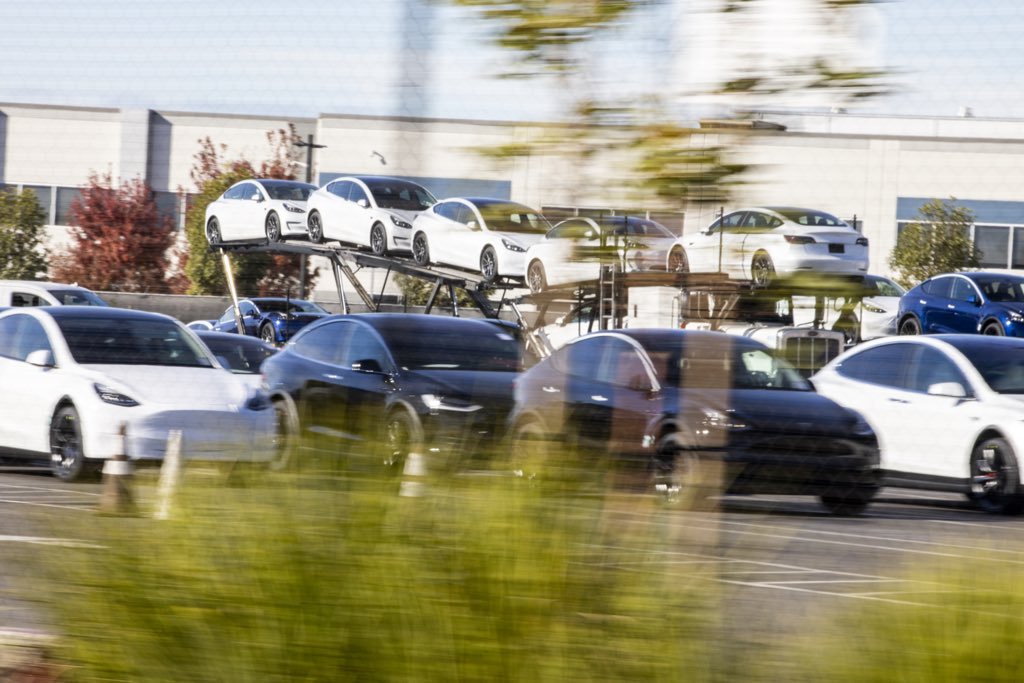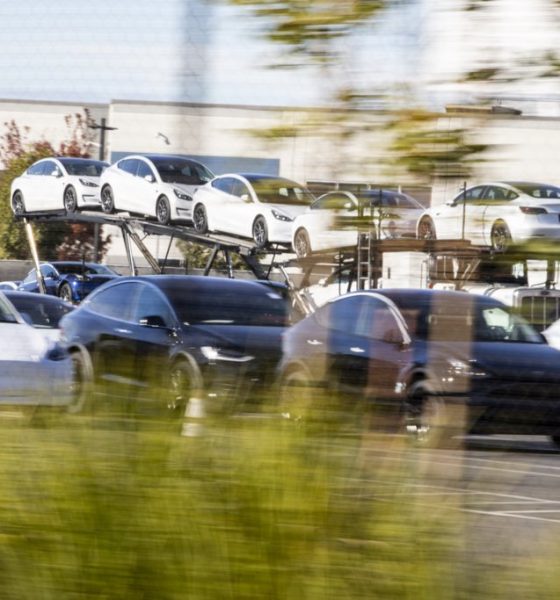

Investor's Corner
Tesla’s Elon Musk calls for an end to TSLA’s end-of-quarter vehicle delivery blitzes
Over the years, it has practically become a tradition for Tesla to engage in a massive “end-of-quarter push” that involves the company working double time in an effort to deliver as many vehicles to as many customers as possible. This, at least according to CEO Elon Musk, must change, as Tesla must come up with a way to reduce the size of its delivery wave in the final weeks of a quarter. By doing so, the company could save on costs, and employees would be saved from burnout.
Musk’s statements about Tesla’s end-of-quarter vehicle delivery blitzes were shared in an email, a screenshot of which was recently shared on Twitter. As per the message, Musk noted that the current quarter is all about minimizing the cost of vehicle deliveries. Thus, it would make sense if the company could avoid spending heavily on expedite fees, overtime, and temporary contractors, just to have everyone burned out at the beginning of the next quarter. The final line of the email is quite notable, as Tesla’s end-of-quarter pushes have partly been done to meet the market’s quarterly expectations.
Here's the full text of @elonmusk's email sent to Tesla employees last night.
Elon making moves to decrease size of end-of-quarter delivery wave. Less attention given to quarterly earnings now that Tesla has been killing it every quarter.
via @DriveTesla1 pic.twitter.com/FpEnqDRqCl
— Dave Lee (@heydave7) November 27, 2021
The following is Musk’s email:
Per my email several weeks ago, our focus this quarter should be on minimizing *cost* of deliveries, rather than spending heavily on expedite fees, overtime, and temporary contractors just so that cars arrive in Q4.
What has happened historically is that we sprint like crazy at end of quarter to maximize deliveries, but then deliveries drop massively in the first few weeks of the quarter. In effect, looked at over a six month period, we won’t have delivered any extra cars, but we would have spent a lot of extra money and burned ourselves out to accelerate deliveries in the last two weeks of each quarter!
We will still have quite a big wave of deliveries in the last few weeks of December, as we don’t yet have high volume production in Europe or Texas, which means a lot of cars on boats from China to Europe and on trucks/rail from California to the east coast arriving late in the quarter, but this is nonetheless the right time to start reducing the size of the wave in favor of a steadier and more efficient pace of deliveries. The right principle is: take the most efficient action, as though we were not publicly traded and the notion of “end of quarter” didn’t exist.
Thanks,
Elon
#Denver @tesla dominated deliveries this week. Unconfirmed reports of 200+ cars delivered both Friday, Saturday alone. Along side Tesla were 30 volunteers providing 40+ hours helping deliver and teach new owners, including a new #Model3 for @kimbal. Props to @elonmusk and team! pic.twitter.com/bmIaCZQNdg
— Sean Mitchell (@seanmmitchell) September 30, 2018
The Tesla CEO’s thesis on his message makes quite a lot of sense, especially considering the lengths that the company and its employees have gone through during the final weeks of every quarter. It was not rare in the past to have practically the entire workforce of Tesla working on vehicle deliveries, and in areas such as the United States and China, even regular owners have stepped in to help the company deliver as many electric cars as possible.
In Q3 2018, for example, Tesla volunteers across the United States helped with the company’s end-of-quarter push, aiding new owners by helping them download the Tesla mobile app and answering questions about their new vehicles. In Denver alone, some Tesla owners volunteered and provided over 40 hours of their personal time to help out. The same was true for China, as experienced owners also made it a point to aid newcomers with their electric cars’ features.
But while community-driven initiatives are admirable, Tesla has reached a point and volume where the company must focus intently on efficiency. Relying on end-of-quarter blitzes with millions of vehicles to be delivered would likely not be sustainable, after all, As Musk noted, this would involve the creation of a steadier and more efficient pace of vehicle deliveries. Such should be more plausible in the coming months, especially as Tesla starts operations in Gigafactory Berlin and Giga Texas.
Don’t hesitate to contact us with news tips. Just send a message to tips@teslarati.com to give us a heads up.

Investor's Corner
Tesla price target boost from its biggest bear is 95% below its current level

Tesla stock (NASDAQ: TSLA) just got a price target boost from its biggest bear, Gordon Johnson of GLJ Research, who raised his expected trading level to one that is 95 percent lower than its current trading level.
Johnson pushed his Tesla price target from $19.05 to $25.28 on Wednesday, while maintaining the ‘Sell’ rating that has been present on the stock for a long time. GLJ has largely been recognized as the biggest skeptic of Elon Musk’s company, being particularly critical of the automotive side of things.
Tesla has routinely been called out by Johnson for negative delivery growth, what he calls “weakening demand,” and price cuts that have occurred in past years, all pointing to them as desperate measures to sell its cars.
Johnson has also said that Tesla is extremely overvalued and is too reliant on regulatory credits for profitability. Other analysts on the bullish side recognize Tesla as a company that is bigger than just its automotive side.
Many believe it is a leader in autonomous driving, like Dan Ives of Wedbush, who believes Tesla will have a widely successful 2026, especially if it can come through on its targets and schedules for Robotaxi and Cybercab.
Justifying the price target this week, Johnson said that the revised valuation is based on “reality rather than narrative.” Tesla has been noted by other analysts and financial experts as a stock that trades on narrative, something Johnson obviously disagrees with.
Dan Nathan, a notorious skeptic of the stock, turned bullish late last year, recognizing the company’s shares trade on “technicals and sentiment.” He said, “From a trading perspective, it looks very interesting.”
Tesla bear turns bullish for two reasons as stock continues boost
Johnson has remained very consistent with this sentiment regarding Tesla and his beliefs regarding its true valuation, and has never shied away from putting his true thoughts out there.
Tesla shares closed at $431.40 today, about 95 percent above where Johnson’s new price target lies.
Investor's Corner
Tesla gets price target bump, citing growing lead in self-driving

Tesla (NASDAQ: TSLA) stock received a price target update from Pierre Ferragu of Wall Street firm New Street Research, citing the company’s growing lead in self-driving and autonomy.
On Tuesday, Ferragu bumped his price target from $520 to $600, stating that the consensus from the Consumer Electronics Show in Las Vegas was that Tesla’s lead in autonomy has been sustained, is growing, and sits at a multiple-year lead over its competitors.
CES 2026 validates Tesla’s FSD strategy, but there’s a big lag for rivals: analyst
“The signal from Vegas is loud and clear,” the analyst writes. “The industry isn’t catching up to Tesla; it is actively validating Tesla’s strategy…just with a 12-year lag.”
The note shows that the company’s prowess in vehicle autonomy is being solidified by lagging competitors that claim to have the best method. The only problem is that Tesla’s Vision-based approach, which it adopted back in 2022 with the Model 3 and Model Y initially, has been proven to be more effective than competitors’ approach, which utilizes other technology, such as LiDAR and sensors.
Currently, Tesla shares are sitting at around $433, as the company’s stock price closed at $432.96 on Tuesday afternoon.
Ferragu’s consensus on Tesla shares echoes that of other Wall Street analysts who are bullish on the company’s stock and position within the AI, autonomy, and robotics sector.
Dan Ives of Wedbush wrote in a note in mid-December that he anticipates Tesla having a massive 2026, and could reach a $3 trillion valuation this year, especially with the “AI chapter” taking hold of the narrative at the company.
Ives also said that the big step in the right direction for Tesla will be initiating production of the Cybercab, as well as expanding on the Robotaxi program through the next 12 months:
“…as full-scale volume production begins with the autonomous and robotics roadmap…The company has started to test the all-important Cybercab in Austin over the past few weeks, which is an incremental step towards launching in 2026 with important volume production of Cybercabs starting in April/May, which remains the golden goose in unlocking TSLA’s AI valuation.”
Tesla analyst breaks down delivery report: ‘A step in the right direction’
Tesla has transitioned from an automaker to a full-fledged AI company, and its Robotaxi and Cybercab programs, fueled by the Full Self-Driving suite, are leading the charge moving forward. In 2026, there are major goals the company has outlined. The first is removing Safety Drivers from vehicles in Austin, Texas, one of the areas where it operates a ride-hailing service within the U.S.
Ultimately, Tesla will aim to launch a Level 5 autonomy suite to the public in the coming years.
Investor's Corner
Tesla Q4 delivery numbers are better than they initially look: analyst
The Deepwater Asset Management Managing Partner shared his thoughts in a post on his website.

Longtime Tesla analyst and Deepwater Asset Management Managing Partner Gene Munster has shared his insights on Tesla’s Q4 2025 deliveries. As per the analyst, Tesla’s numbers are actually better than they first appear.
Munster shared his thoughts in a post on his website.
Normalized December Deliveries
Munster noted that Tesla delivered 418k vehicles in the fourth quarter of 2025, slightly below Street expectations of 420k but above the whisper number of 415k. Tesla’s reported 16% year-over-year decline, compared to +7% in September, is largely distorted by the timing of the tax credit expiration, which pulled forward demand.
“Taking a step back, we believe September deliveries pulled forward approximately 55k units that would have otherwise occurred in December or March. For simplicity, we assume the entire pull-forward impacted the December quarter. Under this assumption, September growth would have been down ~5% absent the 55k pull-forward, a Deepwater estimate tied to the credit’s expiration.
“For December deliveries to have declined ~5% year over year would imply total deliveries of roughly 470k. Subtracting the 55k units pulled into September results in an implied December delivery figure of approximately 415k. The reported 418k suggests that, when normalizing for the tax credit timing, quarter-over-quarter growth has been consistently down ~5%. Importantly, this ~5% decline represents an improvement from the ~13% declines seen in both the March and June 2025 quarters.“
Tesla’s United States market share
Munster also estimated that Q4 as a whole might very well show a notable improvement in Tesla’s market share in the United States.
“Over the past couple of years, based on data from Cox Automotive, Tesla has been losing U.S. EV market share, declining to just under 50%. Based on data for October and November, Cox estimates that total U.S. EV sales were down approximately 35%, compared to Tesla’s just reported down 16% for the full quarter. For the first two months of the quarter, Cox reported Tesla market share of roughly a 65% share, up from under 50% in the September quarter.
“While this data excludes December, the quarter as a whole is likely to show a material improvement in Tesla’s U.S. EV market share.“








